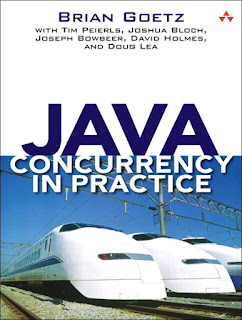Is "Java Concurrency in Practice" still valid in the era of Java 8 and 11?
阿新 • • 發佈:2018-12-28
One of my reader Shobhit asked this question on my blog post about 12 must-reads advanced Java books for intermediate programmers - part1. I really like the question and thought that many Java programmers might have the same doubt whenever someone recommends them to read Java Concurrency in Practice. When this book came first in 2006, Java world was still not sure of about new concurrency changes made in Java 1.5, I think the first big attempt to improve Java's built-in support for multi-threading and concurrency. Many Java programmers were even not aware of new tools introduced in the API e.g.  The most important thing this book introduce was clear concepts and fundamentals of concurrent programming e.g. visibility, ordering,
The most important thing this book introduce was clear concepts and fundamentals of concurrent programming e.g. visibility, ordering,  Now, coming back to Java 8, yes from Java 1.5 to Java 8, JDK have a lot more new tools to implement concurrency and design better Java concurrent application. The introduction of fork-join pool in JDK 7, CompleteableFutures in Java 8 and most importantly the new functional style of coding in Java 8 supported by the lambda expression.
You also got the stream and parallel stream which allows developers to take advantage of concurrency without coding it. The overall idea of moving concurrency from application developer to API developers also makes it little easier and reduced risk of implementing concurrency in Java.
It also means that now you can perform the bulk operation in Java with just a couple of methods and multiple threads without writing a single line of code involving threads, synchronized keyword, or wait-notify methods.
No doubt, that Java developer has to learn these new tools to keep themselves up-to-date and a book like Java 8 in Action really helps on that front. It introduces you to all new changes in Java 8 and not only teaches you how to use them in your day-to-day task but also explains the motivation behind them to understand the bigger picture.
Now, coming back to Java 8, yes from Java 1.5 to Java 8, JDK have a lot more new tools to implement concurrency and design better Java concurrent application. The introduction of fork-join pool in JDK 7, CompleteableFutures in Java 8 and most importantly the new functional style of coding in Java 8 supported by the lambda expression.
You also got the stream and parallel stream which allows developers to take advantage of concurrency without coding it. The overall idea of moving concurrency from application developer to API developers also makes it little easier and reduced risk of implementing concurrency in Java.
It also means that now you can perform the bulk operation in Java with just a couple of methods and multiple threads without writing a single line of code involving threads, synchronized keyword, or wait-notify methods.
No doubt, that Java developer has to learn these new tools to keep themselves up-to-date and a book like Java 8 in Action really helps on that front. It introduces you to all new changes in Java 8 and not only teaches you how to use them in your day-to-day task but also explains the motivation behind them to understand the bigger picture.
 Even though Java Concurrency in Practice in its current state doesn't cover all these important concepts and tools, it's still an invaluable book to learn the fundamentals of threads, concurrency and multi-threading tools supported by Java programming language.
It's still a must-read book for any Java developer who wants to learn and master multi-threading and concurrency, the biggest advantage of using Java for application development.
Java developers are thankful to Brian Goetz, Joshua Bloch and all the authors for giving Java developer such authority book to understand the confusing but critical concepts of multi-threading and concurrency.
Having said that, like many Java developers around the world, I would also love to see a newer, more up-to-date version of Java Concurrency in Practice to cover tools and methodologies introduced in Java 6, 7, 8, 9, 10 and maybe in Java 11 in coming months, much like the updated version of Effective Java and Head First design pattern which covers Java 8 and teaches you how certain patterns are easier to implement with new Java 8 features.
So, let's hope Brian Goetz and other authors of the book listen to this request and gift Java developers around the world with a new version of Java Concurrency in Practice in 2018 until then Dr. Heinz Kabutz' Java Concurrency in Practice Bundle can be used to keep yourself up-to-date.
Even though Java Concurrency in Practice in its current state doesn't cover all these important concepts and tools, it's still an invaluable book to learn the fundamentals of threads, concurrency and multi-threading tools supported by Java programming language.
It's still a must-read book for any Java developer who wants to learn and master multi-threading and concurrency, the biggest advantage of using Java for application development.
Java developers are thankful to Brian Goetz, Joshua Bloch and all the authors for giving Java developer such authority book to understand the confusing but critical concepts of multi-threading and concurrency.
Having said that, like many Java developers around the world, I would also love to see a newer, more up-to-date version of Java Concurrency in Practice to cover tools and methodologies introduced in Java 6, 7, 8, 9, 10 and maybe in Java 11 in coming months, much like the updated version of Effective Java and Head First design pattern which covers Java 8 and teaches you how certain patterns are easier to implement with new Java 8 features.
So, let's hope Brian Goetz and other authors of the book listen to this request and gift Java developers around the world with a new version of Java Concurrency in Practice in 2018 until then Dr. Heinz Kabutz' Java Concurrency in Practice Bundle can be used to keep yourself up-to-date.
 The most important thing this book introduce was clear concepts and fundamentals of concurrent programming e.g. visibility, ordering,
The most important thing this book introduce was clear concepts and fundamentals of concurrent programming e.g. visibility, ordering,  Now, coming back to Java 8, yes from Java 1.5 to Java 8, JDK have a lot more new tools to implement concurrency and design better Java concurrent application. The introduction of fork-join pool in JDK 7, CompleteableFutures in Java 8 and most importantly the new functional style of coding in Java 8 supported by the lambda expression.
You also got the stream and parallel stream which allows developers to take advantage of concurrency without coding it. The overall idea of moving concurrency from application developer to API developers also makes it little easier and reduced risk of implementing concurrency in Java.
It also means that now you can perform the bulk operation in Java with just a couple of methods and multiple threads without writing a single line of code involving threads, synchronized keyword, or wait-notify methods.
No doubt, that Java developer has to learn these new tools to keep themselves up-to-date and a book like Java 8 in Action really helps on that front. It introduces you to all new changes in Java 8 and not only teaches you how to use them in your day-to-day task but also explains the motivation behind them to understand the bigger picture.
Now, coming back to Java 8, yes from Java 1.5 to Java 8, JDK have a lot more new tools to implement concurrency and design better Java concurrent application. The introduction of fork-join pool in JDK 7, CompleteableFutures in Java 8 and most importantly the new functional style of coding in Java 8 supported by the lambda expression.
You also got the stream and parallel stream which allows developers to take advantage of concurrency without coding it. The overall idea of moving concurrency from application developer to API developers also makes it little easier and reduced risk of implementing concurrency in Java.
It also means that now you can perform the bulk operation in Java with just a couple of methods and multiple threads without writing a single line of code involving threads, synchronized keyword, or wait-notify methods.
No doubt, that Java developer has to learn these new tools to keep themselves up-to-date and a book like Java 8 in Action really helps on that front. It introduces you to all new changes in Java 8 and not only teaches you how to use them in your day-to-day task but also explains the motivation behind them to understand the bigger picture.
 Even though Java Concurrency in Practice in its current state doesn't cover all these important concepts and tools, it's still an invaluable book to learn the fundamentals of threads, concurrency and multi-threading tools supported by Java programming language.
It's still a must-read book for any Java developer who wants to learn and master multi-threading and concurrency, the biggest advantage of using Java for application development.
Java developers are thankful to Brian Goetz, Joshua Bloch and all the authors for giving Java developer such authority book to understand the confusing but critical concepts of multi-threading and concurrency.
Having said that, like many Java developers around the world, I would also love to see a newer, more up-to-date version of Java Concurrency in Practice to cover tools and methodologies introduced in Java 6, 7, 8, 9, 10 and maybe in Java 11 in coming months, much like the updated version of Effective Java and Head First design pattern which covers Java 8 and teaches you how certain patterns are easier to implement with new Java 8 features.
So, let's hope Brian Goetz and other authors of the book listen to this request and gift Java developers around the world with a new version of Java Concurrency in Practice in 2018 until then Dr. Heinz Kabutz' Java Concurrency in Practice Bundle can be used to keep yourself up-to-date.
Even though Java Concurrency in Practice in its current state doesn't cover all these important concepts and tools, it's still an invaluable book to learn the fundamentals of threads, concurrency and multi-threading tools supported by Java programming language.
It's still a must-read book for any Java developer who wants to learn and master multi-threading and concurrency, the biggest advantage of using Java for application development.
Java developers are thankful to Brian Goetz, Joshua Bloch and all the authors for giving Java developer such authority book to understand the confusing but critical concepts of multi-threading and concurrency.
Having said that, like many Java developers around the world, I would also love to see a newer, more up-to-date version of Java Concurrency in Practice to cover tools and methodologies introduced in Java 6, 7, 8, 9, 10 and maybe in Java 11 in coming months, much like the updated version of Effective Java and Head First design pattern which covers Java 8 and teaches you how certain patterns are easier to implement with new Java 8 features.
So, let's hope Brian Goetz and other authors of the book listen to this request and gift Java developers around the world with a new version of Java Concurrency in Practice in 2018 until then Dr. Heinz Kabutz' Java Concurrency in Practice Bundle can be used to keep yourself up-to-date.
